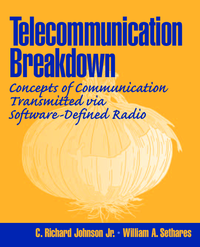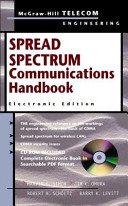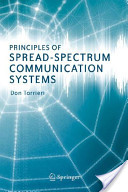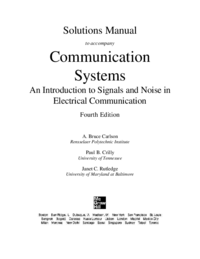Etiqueta "Digital Communications"
Se han encontrado 4 Coincidencias
Telecommunication Breakdown: Concepts of Communication Transmitted Via Software-Defined Radio
142 Visitas | 262 Descargas | 2013-09-26 19:13:39 | cgalgora
This book reflects the recent shift in telecommunications technology from hardware to software by focusing on the design of a digital software-defined radio. "Telecommunications Breakdown" helps readers build a complete digital radio that includes each part of a typical digital communication system. By following each chapter, users create a Matlab realization of the various pieces of a typical digital communication system, exploring key ideas along the way. It defines the three steps in the creation of a working digital radio: building the pieces, assessing the performance of the pieces, and integrating the pieces together. In the final chapter, the reader " puts it all together" to build a fully functional receiver (not operational in real time). For workers in the field of telecommunications.

Spread Spectrum Communications Handbook
119 Visitas | 189 Descargas | 2013-09-26 19:19:51 | cgalgora
This comprehensive guide provides cutting edge information on lead-free, halogen-free, and conductive-adhesive technologies and their application to low-cost, high-density, reliable, and green products. Essential for electronics manufacturing and packaging professionals who wish to master lead-free, halogen-free, and conductive-adhesive problem solving methods, and those demanding cost-effective designs and high-yield environmental benign manufacturing processes, this valuable reference covers all aspects of this fast-growing field. Written for design, materials, process, equipment, manufacturing, reliability, component, packaging, and system engineers, and technical and marketing managers in electronics and photonics packaging and interconnection, this book teaches a practical understanding of the cost, design, materials, process, equipment, manufacturing, and reliability issues of lead-free, halogen-free, and conductive-adhesive technologies.; Among the topics explored: chip (wafer) level interconnects with lead-free solder bumps; lead-free solder wafer bumping with micro-ball mounting and paste printing methods; lead-free solder joint reliability of WLCSPs on organic and ceramic substrates; chip (wafer) level interconnects with solderless bumps such as Ni-Au, Au, and Cu, Cu wires, Au wires, Au studs, and Cu studs; design, materials, process, and reliability of WLCSPs with solderless interconnects on PCB/substrate; halogen-free molding compounds for PQFP, PBGA, and MAP-PBGA packages; environmentally benign die-attach films for PQFP and PBGA packages and lead-free die-attach bonding techniques for IC packaging; environmental issues for conventional PCBs and substrates; some environmentally conscious flame-retardants for PCBs and organic substrates; emerging technologies for fabricating environmental friendly PCBs such as design for environment, green PCB manufacturing, and environmental safety.; It also includes the topics: lead-free soldering activities such as legislation, consortia programs, and regional preferences on lead-free solder alternatives; criteria, development approaches, and varieties of alloys and properties of lead-free solders; physical, mechanical, chemical, electrical, and soldering properties of lead-free solders; manufacturing process and performance of lead-free surface finishes for both PCB and component applications; implementation and execution challenges of lead-free soldering, especially for the reflow and wave soldering process; fundamental understanding of electrically conductive adhesive (ECA) technology; effects of lubricant removal and cure shrinkage on ECAs; mechanisms underlying the contact resistance shifts of ECAs; effects of electrolytes and moisture absorption on contact resistance shifts of ECAs; and stabilization of contact resistance of ECAs using various additives.

Principles of Spread-Spectrum Communication Systems
127 Visitas | 189 Descargas | 2013-09-26 19:26:07 | cgalgora
Originally adopted in military networks as a means of ensuring secure communication when confronted with the threats of jamming and interception, spread-spectrum systems are now the core of commercial applications such as mobile cellular and satellite communication. This book provides a concise but lucid explanation and derivation of the fundamentals of spread-spectrum communication systems. The level of presentation is suitable for graduate students with a prior graduate-level course in digital communication and for practicing engineers with a solid background in the theory of digital communication. As the title indicates, the author focuses on principles rather than specific current or planned systems. Although the exposition emphasizes theoretical principles, the choice of specific topics is tempered by their practical significance and interest to both researchers and system designers. Throughout the book, learning is facilitated by many new or streamlined derivations of the classical theory. Problems at the end of each chapter are intended to assist readers in consolidating their knowledge and to provide practice in analytical techniques. Principles of Spread-Spectrum Communication Systems is largely self-contained mathematically because of the four appendices, which give detailed derivations of mathematical results used in the main text.

Solutions Manual to accompany Communication Systems An Introduction to Signals and Noise in Electrical Communication
Fundamento de las comunicaciones. Telecomunicaciones y electrónica
60 Visitas | 41 Descargas | 2021-04-21 04:47:21 | dhera
Manual de soluciones a los ejercicios del Libro de fundamento de las comunicaciones Communication Systems An Introduction to Signals and Noise in Electrical Communication. Este libro en formato PDF es útil para estudiantes de las carrera de Telecomunicaciones y electrónica
Contribuir
Usted puede contribuir con Libros UCLV, es importante para nosotros su aporte..
Contribuir